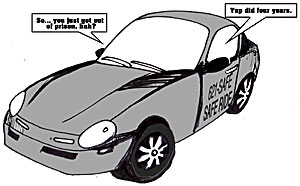
Illustration by Arnie Bermudez
|
|
By Moe Naqvi
Arizona Daily Wildcat
Friday, November 19, 2004
Print this
Students at the UA have been using the SafeRide service provided by ASUA since 1994, and it's been a prosperous venture that has helped many students. Although SafeRide is one awesome little advantage for UA students, there are many more features that can be altered or added that would make SafeRide a lot safer.
Numerous times have I heard from friends or fellow colleagues that they have almost been run over by SafeRide cars (which is rather ironic), been rejected for a pick up or that the drivers just aren't very pleasurable.
There are more than a handful of ideas SafeRide should consider before starting up next semester, and I'm here to give it to them. First of all, a prerequisite for all SafeRide drivers should be that they pass a psychological health test. A thorough mental examination would allow for the SafeRide program to be sure that the drivers in the SafeRide car would be dependable and stable.
Most people think SafeRide drivers are considered to be peaceful and "safe." No one would ever really suspect a SafeRide driver if a sudden spree of hitting pedestrians and bicyclists were to occur because that would just be insane. However, firsthand accounts from students have led me to believe that sometimes SafeRide drivers aren't all that safe.
"This one night I was crossing University, and a SafeRide car turned right into my direction. The driver made eye contact with me, and unless he had glaucoma, he should have definitely stopped. Yet he kept going, and I had to jump back in order to avoid getting hit. It was really traumatic; I wonder if he did it on purpose," said pre-pharmacy freshman Mike Ferracane.
Sure, SafeRide provides students with a safety roof, but on those rare occasions, their drivers are also sometimes the ones causing safety concerns. A psychological health test would make sure that SafeRide drivers are stable and that there is no hidden agenda to actually hunt down unsuspecting UA students and run them over.
Secondly, SafeRide rejects groups larger than two. Although SafeRide will carry up to four people at a time, they have to be two different groups of people. So if an individual is with two other friends, the third friend will not be able to travel in the car. SafeRide's rationale is that if a person is in a group larger than two, then that person should feel no harm. But this rationale is flawed. What if there is a group of three lightweight girls in the middle of the night? Two 200-pound guys would have no trouble going King Kong and fighting those girls. Just because there is a group of people does not necessarily mean that there is a larger halo of safety.
SafeRide will also not pick up students on weekends or if they are blatantly drunk. Last time I checked, UA students need the most safety around those times. Letting a drunk teen walk home at 3 a.m. on a Saturday is like letting a 2-year-old ride Sun Tran to the Bunny Ranch: totally not safe or morally right. There are boundaries to where SafeRide can be utilized, which is completely acceptable. But if there are drunk students within those limits, they should have every right to make it back to their destination safely. The university should look out for the students who pay thousands of dollars to attend their institution. It's the least they could do.
Lastly, in order to amplify the level of pleasure during a SafeRide drive, another prerequisite for becoming a driver must be that the applicant is an ex-convict. An ex-convict will not only be able to scare off any potential hijackers or meanies, but they will also have plenty of entertaining stories to tell. Ex-convicts deserve a chance to give back to society, and putting them in the driver seat, as long as they pass the psychological health test, will be nothing less than pleasurable. Everyone wins.
SafeRide is already a good service, but it can definitely be made better with a few of my suggested improvements.
Moe Naqvi is a physiological sciences freshman. He can be reached at letters@wildcat.arizona.edu.
